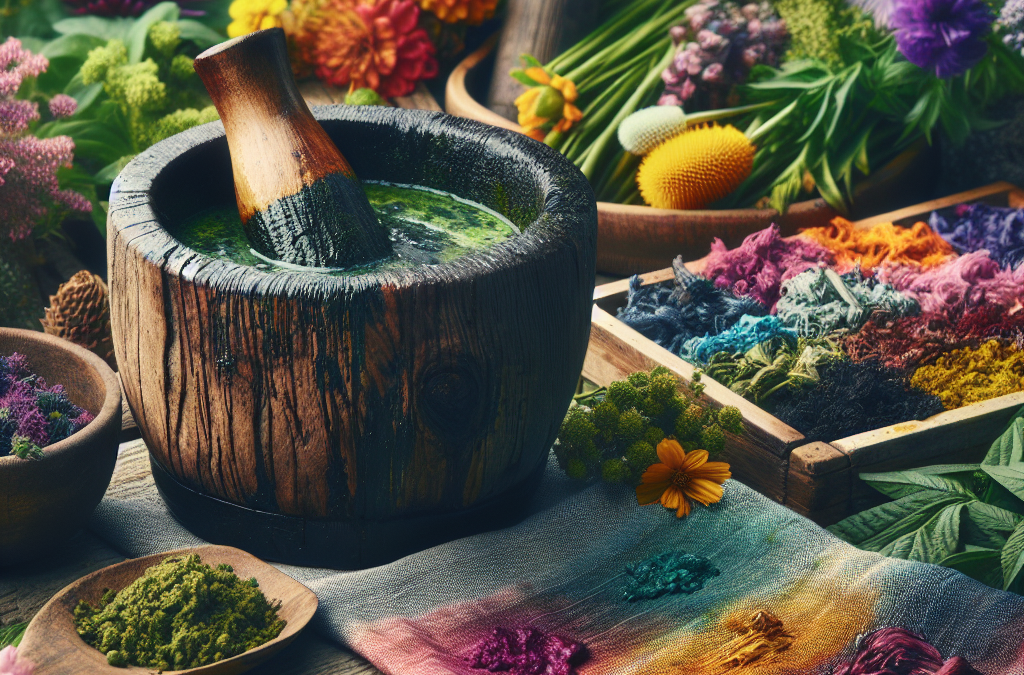Gathering Your Materials
Choosing the Right Plants
First things first, when it comes to natural dyes, knowing what plants to use is key. You probably have some potential dye plants growing in your garden right now! Some of my favorites are marigolds for bright yellows, beets for deep reds, and spinach for a lovely green hue. Take a stroll through your garden or even your backyard, and be on the lookout for vibrant colors.
It’s not just about the flowers; even common weeds can surprise you! Dandelions, for instance, are not just pesky plants; they can yield beautiful yellows. I remember the first time I discovered that, it felt like I’d unlocked a secret treasure in my garden.
Don’t forget to check out your local herbal store or farmer’s market, too. You can find all kinds of plant materials there, including roots and shrubs, that lend themselves perfectly to dye-making!
Gathering Supplies
Now that you know what plants to look for, let’s chat about supplies. You’re gonna need some basic stuff like pots, water, and a heat source. I like to use my old cooking pots; just make sure they’re not your favorite ones, as natural dyes can be super intense and potentially stain.
You might also want some jars for storing your dyes once they’re ready to go. I always keep a few glass jars on hand—they’re great for seeing the colors you create! Plus, gloves are a lifesaver, especially if you’re working with beets or any overly pigmented plants.
Lastly, grab some fabric or yarn that you want to dye. Natural fibers work best—think cotton, linen, or wool. If you use synthetics, the dyes won’t hold very well, and who wants that?
Setting Up Your Workspace
Creating a comfy workspace is important, as dyeing can get messy! I usually cover my table with an old cloth or newspaper to catch any spills. You might also want to wear an apron or old clothes that you don’t mind getting stained.
Make sure you have good ventilation. Open a window or work outside when it’s nice out. The last thing you want is to breathe in any fumes from boiling plants. A cozy environment helps keep your spirits high while you create.
Also, try to keep everything organized. Keep your plants, pots, and materials laid out within reach to avoid running around. Trust me, being orderly makes the process so much easier and more enjoyable.
Preparing the Plant Material
Harvesting the Plants
Once your workspace is ready, it’s time to harvest the plants! Make sure to pick them when they’re at their freshest—this will give you the best dye results. I often do my harvesting in the early morning when the dew is still on the leaves, which just feels magical!
Gather enough material to fill about half your pot when it’s packed down. The more plant material you use, the richer your color will be. Just be sure to leave some plants in your garden to keep the ecosystem balanced.
As you’re collecting, try to have fun! Talk to the plants as if they’re listening. It sounds silly, but I swear it adds to the experience and makes you feel connected to nature.
Preparing the Plants for Dyeing
To prepare the plants, you’ll want to chop them into smaller pieces. This helps release their pigments more effectively. I usually chop them down to about an inch or so to get the best results.
After chopping, rinse them well to remove any dirt or bugs. You wouldn’t want those little guys creeping into your dye bath! I like to fill my trusty colander with plant pieces and give them a good rinse under cool water.
For tougher materials like roots, consider pulverizing them. A simple food processor or even a good old mortar and pestle can do the trick. It may seem like a lot of work, but it’s so worth it when you see those vibrant colors emerge!
Simmering the Plant Material
Next up is the simmering phase! Place your chopped plants in a pot, cover them with water (enough to fully submerge them), and bring it to a gentle boil. I like to use the lowest heat possible to let the dyes seep out slowly. It’s almost therapeutic just watching it bubble away.
Let your plants simmer for at least an hour, but feel free to leave them for even longer if you want a deeper color payoff. Just keep an eye on the water level, adding more if it starts to evaporate. Losing too much liquid can lead to uneven results.
After a while, check on your dye to see if you love the color. It’s important to taste your dye—just kidding, please don’t! However, amusingly, I often give it a tiny sniff to gauge how vibrant it is. You can strain it through a sieve to separate the liquid from the plant material when you’re happy with it.
Dyeing the Fabric or Yarn
Prepping the Fabric or Yarn
Before plunging your fabric or yarn into the dye bath, it needs to be prepped. I usually soak mine in a mixture of water and a mordant, such as alum, which helps the fibers lock in the color. This step is super crucial for ensuring your colors pop!
Make sure to follow the instructions on any mordant you choose, as ratios can vary. I like to let the fabric soak for at least an hour before moving on to the fun part. Once the fabric is well-prepped, give it a gentle rinse to get rid of any excess mordant.
Don’t be impatient—this extra step will lead to vibrant and lasting results, trust me. I’ve done it both ways, and the difference is like night and day!
Dyeing Process
Now it’s showtime! Carefully place your prepared fabric or yarn into the dye bath. Make sure it’s fully submerged. I usually use a wooden spoon to stir it gently and evenly distribute the dye.
Keep an eye on it—dyeing can go quickly, so check every 10-15 minutes to see how the color develops. You might be amazed at how fast it transforms. Each time I dye, I feel like a kid watching the magic happen!
Once you reach your desired shade, remove the fabric from the pot and rinse it under cool water. This helps remove any excess dye and locks in the color. Depending on the plant material, you might even notice different shades across the fabric, making it unique and beautiful.
Setting the Dye
After rinsing, it’s time to set that dye! I like to hang mine up to dry in a shady area, away from direct sunlight, which can fade the colors. You can also iron the fabric once it’s dry, which can help to set the dye even more.
At this stage, pat yourself on the back! You’ve worked hard, and the end result is truly rewarding. I can tell you that seeing those gorgeous colors on my fabric is always worth the effort.
If you want to make your dye last even longer, consider giving it a wash with a gentle detergent before using it. It’ll help ensure your beautiful handiwork doesn’t leave a mark on your clothes or anything else!
Storing and Using Your Natural Dyes
Storing Techniques
It’s essential to store your natural dyes correctly so they can be used later. If you have excess dye left over, pour it into clean jars and store it in the fridge for a couple of weeks. I often label my jars, so I can remember what plant created each color. It’s like having a mini rainbow every time I open my fridge!
For long-term storage, you might want to freeze the dye. Simply pour it into ice cube trays, freeze, and transfer the cubes into labeled bags. This way, you can pop out just the amount you need for your next project.
Make sure to check on your stored dyes occasionally. Just like food, natural dyes can spoil, so keep an eye out for any odd smells or changes in texture.
Using Dyes for Creative Projects
Now, onto the fun part—using your beautiful natural dyes! You can use them to fit your crafting needs, whether it’s for fabric arts, clothing, or home decor. I find joy in experimenting with shibori or tie-dye techniques, which create vibrant patterns in unique ways!
Layering different natural dyes can also yield stunning combinations. I remember experimenting with turmeric and indigo, and let’s just say, the results were jaw-dropping! Your creativity really is your only limit.
Remember, the beauty of natural dyes is not just in how they look but also in knowing they come from the earth, which adds depth to all your creations. Talk about a conversation starter!
Sharing Your Natural Dye Experience
Once you’ve created beautiful pieces, consider sharing them! Show them off on social media or with friends and family. I love sharing my experiences; you never know who might be inspired to try their hand at dyeing with plants.
You could even organize a small get-together or workshop in your community. Teaching others how to make their own natural dyes can be incredibly fulfilling, and you can all swap ideas and techniques.
Ultimately, natural dyeing is about connection—with nature, creativity, and each other. So, dive into this colorful journey, and let your imagination run wild!
FAQs about Making Natural Dyes from Plants in Your Garden
1. What plants can I use to make natural dyes?
You can use a variety of plants! Common choices include marigolds for yellow, beets for red, spinach for green, and onion skins for orange and brown. Be sure to experiment with whatever you have available!
2. How long do natural dyes last?
Natural dyes can last a long time if properly stored. Refrigerated dyes can last for a couple of weeks, while frozen dyes can be stored for several months. As with anything, check for any signs of spoilage!
3. Do I need a mordant for natural dyes?
Yes, using a mordant like alum helps fix the dye to the fabric, ensuring the color is brighter and lasts longer. It’s an essential step that should not be skipped!
4. Can I dye synthetic fabrics with natural dyes?
While it’s possible, synthetic fabrics do not hold natural dyes as well as natural fibers. For the best results, stick to cotton, linen, or wool!
5. Is natural dyeing safe?
Absolutely! Natural dyes made from plants are generally safe to use. Just make sure that any plants you use are non-toxic and clearly identifiable. Always take precautions, like wearing gloves, if you’re working with particularly strong dyes.
Related Content
- From Dependence to Independence: A Guide to Building a Life of Self-Sufficiency
- How to Conduct a Soil Test for Gardening
- How to Raise Ducks for Eggs and Meat
- Raising Livestock at Home: Everything You Need to Know About Keeping Animals on Your Property
- How to Start a Community Garden Bringing Neighbors Together





